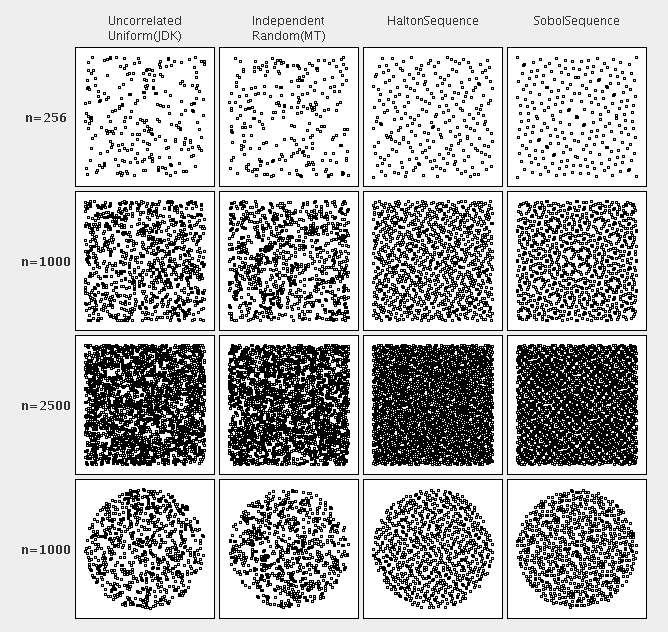2 Data Generation2.1 OverviewUtilities in package o.a.c.m.legacy.random often uses an underlying "source of randomness": A pseudo-random number generator (PRNG) that produces sequences of numbers that are uniformly distributed within their range. Commons Math depends on Commons RNG for the PRNG implementations. 2.2 Correlated random vectorsSome algorithms require random vectors instead of random scalars. When the components of these vectors are uncorrelated, they may be generated simply one at a time and packed together in the vector. When the components are correlated however, generating them is more difficult. The CorrelatedVectorFactory class provides this service. In this case, a complete covariance matrix must be provided (instead of a simple standard deviations vector) gathering both the variance and the correlation information of the probability law. The main use for correlated random vector generation is for Monte-Carlo simulation of physical problems with several variables, for example to generate error vectors to be added to a nominal vector. A particularly common case is when the generated vector should be drawn from a Multivariate Normal Distribution. Generating random vectors from a bivariate normal distribution: import java.util.function.Supplier; import org.apache.commons.rng.UniformRandomProvider; import org.apache.commons.rng.RandomSource; // Import common PRNG interface and factory class that instantiates the PRNG. // Create (and possibly seed) a PRNG. long seed = 17399225432L; // Fixed seed means same results every time UniformRandomProvider rng = RandomSource.create(RandomSource.MT, seed); // Create a a factory of correlated vectors. CorrelatedVectorFactory factory = new CorrelatedVectorFactory(mean, covariance, 1e-12); Supplier<double[]> generator = factory.gaussian(rng); // Use the generator to generate correlated vectors. double[] randomVector = generator.get(); ... mean argument is a double[] array holding the means
of the random vector components. In the bivariate case, it must have length 2.
The covariance argument is a RealMatrix, which has to
be 2 x 2.
The main diagonal elements are the variances of the vector components and the
off-diagonal elements are the covariances.
For example, if the means are 1 and 2 respectively, and the desired standard deviations
are 3 and 4, respectively, then we need to use
double[] mean = {1, 2};
double[][] cov = {{9, c}, {c, 16}};
RealMatrix covariance = MatrixUtils.createRealMatrix(cov);
2.3 Low discrepancy sequences
There exist several quasi-random sequences with the property that for all values of N, the subsequence
x1, ..., xN has low discrepancy, which results in equi-distributed samples.
While their quasi-randomness makes them unsuitable for most applications (i.e. the sequence of values
is completely deterministic), their unique properties give them an important advantage for quasi-Monte Carlo simulations.
// Create a Sobol sequence generator for 2-dimensional vectors RandomVectorGenerator generator = new SobolSequence(2); // Use the generator to generate vectors double[] randomVector = generator.nextVector(); ... 
|



